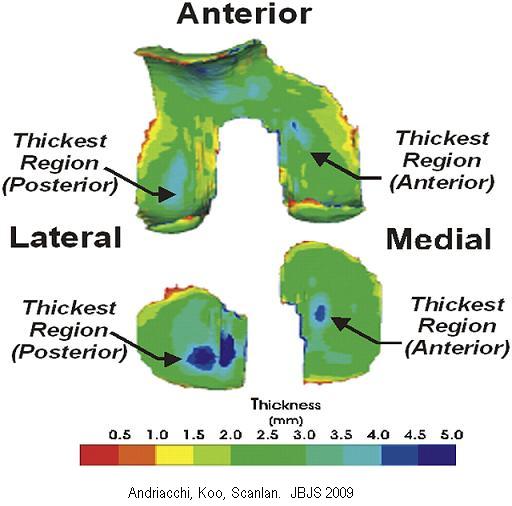Cartilage Morphology and Gait

Goals
- To evaluate the relationship between loading at the knee during locomotion and regional variations in cartilage thickness.
- To evaluate the relationship between a positional offset at the knee during locomotion and regional variations in cartilage thickness.
- To evaluate the relationship between motion at the knee during locomotion and regional variations in cartilage thickness.
Major Findings
- The peak knee adduction moment in walking and medial to lateral thickness ratio in both the femur and tibia is positively correlated.
- The medial to lateral thickness ratio and the medial to lateral contact surface pressure ratio, a surrogate measure of the surface geometry differences, is not signifcantly linearly related.
- The pivoting point in the knee is in the lateral side during normal ambulation.
- Spatial cartilage thickness distribution might be affected by the larger range of the motion in the medial compartment of the knee.
- The knee flexion extension angle at heel strike is associated with the region of thickest cartilage for the medial femoral condyle.
- The knee anterior posterior translation and internal external rotational motions at the knee were not associated with the anterior-posterior locations of thickest cartilage on the tibia as had been hypothesized.
Representative Publications
- Knee joint kinematics during walking influences the spatial cartilage thickness distribution in the knee
Koo S, Rylander JH, Andriacchi TP. J Biomech. 2011 Apr; 44(7)1405-9. - Accuracy of 3D cartilage models generated from MR images is dependent on cartilage thickness: laser scanner based validation of in vivo cartilage.
Koo S, Giori NJ, Gold GE, Dyrby CO, Andriacchi TP. J Biomech Eng. 2009 Dec;131(12). - Gait mechanics influence healthy cartilage morphology and osteoarthritis of the knee.
Andriacchi TP, Koo S, Scanlan SF. J Bone Joint Surg Am. 2009 Feb;91 Suppl 1:95-101. -
The knee joint center of rotation is predominantly on the lateral side during normal walking.
Koo S, Andriacchi TP. J Biomech. 2008;41(6):1269-73. - A comparison of the influence of global functional loads vs. local contact anatomy on articular cartilage thickness at the knee
Koo S, Andriacchi T. Journal of Biomechanics. 2007; 40(13):2961-6. - Considerations in measuring cartilage thickness using MRI: factors influencing reproducibility and accuracy
Koo, S, Gold, G, Andriacchi, T: Osteoarthritis & Cartilage. 2005; 13(9): 782-789. - MR Imaging of Articular Cartilage at 1.5T and 3.0T: Comparison of SPGR and SSFP Sequences
Kornaat P, Reeder S, Koo S, Brittain J, Yu H, Andriacchi T, Gold G: Osteoarthritis and Cartilage. 2005; 13(4): 338-44.
